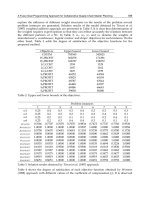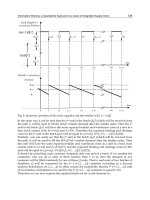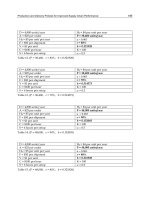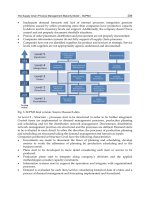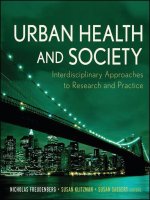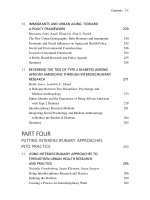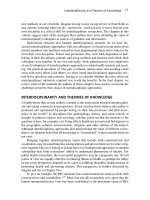Urban Health and Society: Interdisciplinary Approaches to Research and Practice - Part 8 pdf
Bạn đang xem bản rút gọn của tài liệu. Xem và tải ngay bản đầy đủ của tài liệu tại đây (65.67 KB, 10 trang )
Using CBPR to Understand the Health Implications 51
health behavior and health education, sociology, epidemiology, human nutrition, and
environmental health sciences, as well as a wider range of community partners, includ-
ing organizations working on issues of environmental justice.
These new interdisciplinary collaborations enabled the collection of a number of
nutrition - related measures as part of the survey of residents: a semiquantitative food
frequency questionnaire; anthropometric measures of height, weight, and waist cir-
cumference; and a variety of biomarkers (e.g., cholesterol).
43
The survey also included
measures of participants ’ perceptions of the neighborhood food environment. Com-
munity partners provided space where survey participants could come to have their
blood drawn and helped to ensure that data collection procedures were culturally
appropriate and had suitable safeguards for participants ’ confi dentiality. Using these
data, HEP has begun a series of analyses examining relationships among indepen-
dently observed and perceived measures of the retail food environment (e.g., proximity
of different types of retail food outlets; food availability, quality, and price), dietary
behaviors, and related health outcomes (e.g., obesity, serum cholesterol) in residents of
eastside, southwest, and northwest Detroit. Among the initial fi ndings of these analyses
are that residents ’ perceptions of the neighborhood food environment are associated
with factors at multiple levels, including their individual educational attainment, neigh-
borhood racial composition, and store availability.
44
Another analysis revealed that
availability of a large neighborhood grocery store was positively associated with fruit
and vegetable intake and that the neighborhood food environment had stronger effects
on consumption in Latinos compared with African Americans.
45
In 2005, HEP brought in new colleagues from urban planning and received
additional fi nancial support to examine associations between aspects of the built envi-
ronment and obesity risk and to evaluate multilevel interventions centered on the
introduction of greenways in Detroit. In fall 2008 through winter 2009, HEP conducted
a second - wave community survey and reassessed the retail food environment, includ-
ing mapping food store and restaurant locations and assessing the availability, quality,
and price of a range of healthy food options (e.g., produce, low - fat foods, whole - grain
foods) at stores. This new data collection will allow HEP to examine the effects of
changes in the retail food environment on residents ’ dietary behaviors and health indi-
cators over a six - year period. HEP anticipates that the new disciplinary collaborations
will allow for a better understanding of the role of the retail food environment in obe-
sity and related health outcomes by allowing simultaneous examination of the retail
food environment and aspects of the built environment relevant for physical activity
(e.g., land use, street connectivity). It will also assist in identifying relevant commu-
nity change strategies.
With the addition of supplemental pilot funding and the engagement of a geogra-
pher, HEP will also invite a subsample of survey participants to participate in additional
data collection that uses portable global positioning system (GPS) units to measure the
environment to which they are exposed during daily activities ( “ activity - space ” envir-
onments). This will allow HEP to characterize environmental exposures and resources,
including the food environment, in a broader area beyond the residential neighborhood
c03.indd 51c03.indd 51 6/3/09 11:59:00 AM6/3/09 11:59:00 AM
52 Interdisciplinary Research on Urban Food Environments
and to examine relationships among aspects of activity - space environments, health
behaviors including dietary intake, and health outcomes.
Challenges and Lessons Learned
The ESVHWP and HEP both used an interdisciplinary, participatory approach to
study the retail food environment in Detroit. Involvement of community partners and
expansion of the research teams to include investigators from a wider range of disciplines
enriched the work of the partnerships by providing content and methodological expertise,
offering multiple interpretive lenses, and identifying implications for community change
efforts. Based on our experience studying the retail food environment using an interdisci-
plinary, participatory approach in an urban context, we suggest several lessons.
Competing Priorities Interdisciplinary, participatory research projects that are inter-
ested in issues of social justice in urban communities often have ambitious goals and
multiple components. One reason is that economically vulnerable urban communities
face numerous challenges that warrant attention.
40
Another contributing factor is the
wide range of interests of individual members, which refl ect not only diverse disciplin-
ary backgrounds but also organizational priorities. Although the ESVHWP ’ s and HEP ’ s
concentration on the retail food environment arose from community concerns, nutrition,
and more specifi cally the retail food environment, was only one of the foci of these proj-
ects. Limited resources often force partnerships to choose to address a small number of
urban communities ’ many needs. Community planning processes that engage not only
members of the partnership but also community residents and other stakeholders can
help to prioritize community change efforts as well as identify connections to other con-
cerns faced by the community. HEP has recently completed such a community planning
process that prioritized interventions addressing the local food environment as well
as other aspects of the built and social environment that may infl uence obesity and
cardiovascular risk.
Communicating Across Disciplines As we have described, as the need for additional
content and methodological expertise became apparent, members of the partnerships
sought researchers and professionals with a broader range of disciplinary backgrounds:
human nutrition, social and spatial epidemiology, economics, and geography. Some
joined the research teams; others provided critical input into the projects. This array of
disciplinary perspectives introduced disciplinary language and challenges to commu-
nication. The need to communicate with community partners added another layer of
complexity. Reaching common conceptual and methodological understandings
required willingness across partnership members to ask questions when terminology
(e.g., social structure, food security, spatial autocorrelation, land use) or methodolo-
gies (e.g., GPS, accelerometer, spatial regression) were unclear and to provide more
detailed explanations. The fact that many members of the partnerships had training
and/or worked in public health, regardless of disciplinary homes, provided some com-
mon language and experiences that facilitated communication.
c03.indd 52c03.indd 52 6/3/09 11:59:01 AM6/3/09 11:59:01 AM
Using CBPR to Understand the Health Implications 53
Incorporating Diverse Cultural Food Preferences Racial and ethnic diversity is a
distinct characteristic of most U.S. cities. One lesson learned regarding studying the
retail food environment in a multiethnic urban context is the importance of incorporat-
ing cultural food preferences and norms of multiple racial/ethnic groups. Although
more than 80 percent of Detroit residents are African American, communities involved
in the HEP have substantial Latino and white populations, too. Thus, in designing
instruments we used to audit food stores, we attempted to include items that were pop-
ular among all three racial/ethnic groups. We learned that our efforts were partially
successful and have identifi ed area for improvement (e.g., adding more fruits and veg-
etables popular among Mexican Americans in Detroit) in future work. Working closely
with community members can help to ensure that data collection tools are appropriate
for the populations under study.
Understanding the Relationship Between Race and Economics Racial residential
segregation, a defi ning characteristic of metropolitan Detroit and other U.S. metropoli-
tan areas, adversely impacts socioeconomic circumstances of many people of color
and the urban neighborhoods in which they live.
46
As a result, race and socioeconomic
status (SES) are highly correlated at not only the individual level but also the neigh-
borhood level, which makes it diffi cult to tease apart whether spatial access to
nutritional resources and hazards differs by neighborhood racial composition, SES, or
both.
6 ,
41
Yet, because solutions will differ, understanding the role race plays in deci-
sions regarding the placement of retail food outlets, above and beyond the role of SES,
is important. Although more diffi cult to achieve in some urban contexts than in others,
study designs that incorporate neighborhoods in both the city and surrounding suburbs
can introduce suffi cient variation in economic conditions within neighborhoods of
the same racial composition and help to answer questions regarding the role of race
in the distribution of food resources and risks.
Time - Intensive Nature of Research As referenced earlier, considerable time passed
from when residents brought problems of inadequate availability of healthy foods in
Detroit to the forefront of these CBPR initiatives to subsequent stages in the research:
documentation of inequalities in neighborhood retail food environments and examina-
tion of the associations with health behaviors and outcomes. Indeed, HEP ’ s research
examining the role of retail food environment in dietary behaviors and related health
outcomes among Detroit residents is still in its early stages. The time - intensive reali-
ties of forming interdisciplinary, participatory research collaborations; securing
funding; and collecting and analyzing data presented two challenges.
A fi rst challenge was balancing research to understand contributions of the
retail food environment to Detroit residents ’ dietary intakes and health with action.
Community - based participatory research calls for a balance between research and
action.
47
Indeed, Detroit residents described pressing challenges of inadequate avail-
ability of healthy food options in their neighborhoods and limited transportation options
to reach suburban food sources. These needs confl icted with the timeline required to
c03.indd 53c03.indd 53 6/3/09 11:59:01 AM6/3/09 11:59:01 AM
54 Interdisciplinary Research on Urban Food Environments
develop data to inform evidence - based community change strategies that would lead
to improvements in the health of Detroit residents. Ultimately, the ESVHWP pursued
short - term strategies to increase the availability of healthy food options (e.g., develop-
ment of fruit and vegetable minimarkets) at the same time that research continued,
which allowed the partnership to respond to a community - identifi ed need. Yet, while
both partnerships would have liked large - scale policy and program development to
proceed more quickly, these interim strategies were critical to address community con-
cerns in the short term.
Another challenge posed by the time - intensive nature of the research process is
that investigators who offered valuable disciplinary perspectives related to nutrition
and who provided GIS skills have since left the area, which was due to the structure of
academia (postdoctoral and doctoral training) and individual career trajectories. Still,
the initial interdisciplinary relationships that were developed, sustained involvement
of many of the original research team members, engagement of new investigators with
requisite knowledge and skills, and long - distance participation of some team members
using technology (e.g., teleconference, e - mail) have enabled the interdisciplinary work
to continue.
DIRECTIONS FOR FUTURE RESEARCH
Our experiences highlight the importance of engaging communities and casting a wide
disciplinary net in efforts to understand and address the retail food environment in
cities. Because issues may not be the same across cities, community residents and rep-
resentatives can play a critical role in defi ning problems and resources related to the
retail food environment, interpreting fi ndings, and prioritizing and designing change
strategies. In addition to public health, sociology, and nutritional science, theoretical
perspectives and methodologies from disciplines such as geography, economics,
anthropology, and urban planning can greatly enrich research and the understandings
gained from that research. Extant research aimed at understanding and addressing
contributions of the retail food environment to the health of urban populations has
implications for future observational and intervention research.
First, an underlying assumption of most extant epidemiologic research is that resi-
dents, especially in economically disadvantaged urban neighborhoods, rely on foods
available within their residential neighborhood. As a result, most studies have method-
ologically equated food availability in residential neighborhoods with food access or as
a set of available options with respect to food sources (e.g., grocery stores, restaurants)
and the food supply. In fact, an individual ’ s or household ’ s food access likely depends
on their physical (e.g., physical mobility, transportation), economic (e.g., income, food
assistance receipt), and social (e.g., social networks, time - budget) resources and con-
straints. These resources and constraints may, for example, shape individuals ’ activity
spaces and consequently the food environments to which they are exposed beyond the
residential neighborhood. Yet, the interplay of individual/household resources and con-
straints and the local and regional food environment in shaping food access, both in the
c03.indd 54c03.indd 54 6/3/09 11:59:01 AM6/3/09 11:59:01 AM
Directions for Future Research 55
residential neighborhood and broader activity space, in shaping food access and conse-
quently the use of the retail food environment is poorly understood
48
and thus is an
important direction for future research.
Second, studies examining the potential infl uence of the retail food environment
on the health of city populations have generally focused on retail outlet availability
and characteristics of the food supply (e.g., availability, quality, price). Yet, the retail
food environment may impact city residents ’ health through pathways beyond the type
of retail food outlets present and the food supply. For example, utilizing the retail food
environment in economically disadvantaged urban neighborhoods often involves
encountering crime and harassment when entering and leaving stores, deteriorated
conditions inside and surrounding stores, and unfair treatment from store employees
and owners. Stress stemming from these conditions and experiences may negatively
impact urban residents ’ mental well - being and have indirect negative repercussions
for dietary behaviors, weight status, and physical health.
49
Thus, research that exam-
ines health implications of these and other aspects of the retail food environment,
above and beyond food outlet locations and the food supply, will be critical in under-
standing the retail food environment and its implications for health. Community
members can inform the identifi cation and investigation of these other pathways.
Third, understanding the role of the retail food environment in the health of city
populations necessitates reliable and valid measures of multiple dimensions of the
retail food environment. Although measures are increasing, they are currently scarce,
particularly perceptual measures of the retail food environment. Moreover, few studies
have demonstrated the reliability and validity of existing perceived or observational
measures.
50
Interdisciplinary teams, which include community members, can work
together to create and test the properties of these food environment measures.
With respect to intervention research, studies are needed to evaluate the impact of
natural and planned changes in the retail food environment on health status. Additional
studies that evaluate the opening and closing of retail food outlets (e.g., supermarkets,
fast - food restaurants) and changes in food availability, quality, pricing, or product mix
would be informative. Relatively little research has been conducted to date in the
United States, with most research in this area taking place in the United Kingdom.
51 –
53
Moreover, multilevel interventions that combine environmental changes with individ-
ual behavioral change strategies may be an even more promising approach. Still,
researchers should address other aspects of the food environment (e.g., safety, customer
service, cleanliness), beyond increasing the availability of high - quality, reasonably
priced healthy foods, that affect urban residents ’ comfort and willingness to shop at
a store. Furthermore, it is important that researchers pay particular attention to how
change efforts directed at the retail food environment affect the most vulnerable popu-
lations in cities. For example, opening a supermarket in an economically disadvantaged
urban neighborhood may not benefi t economically vulnerable residents if they cannot
afford to shop there. Assuring that all residents have economic as well as spatial access
to healthy foods is essential if we are to address racial and socioeconomic disparities
in health.
c03.indd 55c03.indd 55 6/3/09 11:59:01 AM6/3/09 11:59:01 AM
56 Interdisciplinary Research on Urban Food Environments
In conclusion, we found that use of an interdisciplinary, participatory approach
enhanced our research on the retail food environment in Detroit in several ways.
Community participation and priorities motivated this research. They shaped the
research trajectory, framed the research questions, and helped to ensure the work was
grounded in Detroit ’ s historical and contemporary context. Engagement of multiple
disciplines provided substantive and methodological expertise to conduct the research.
By combining perspectives from disciplines that have traditionally focused on indi-
viduals (such as nursing and nutrition) with those that have focused on societies (such
as sociology and public health), we have moved toward research questions that recog-
nize multiple levels of infl uence on dietary intake refl ecting both structure and
individual agency. New theoretical and methodological ideas have continued to emerge
as we have expanded our literature reviews and research partners to include other dis-
ciplines such as time geography and economics. Ultimately, drawing on the
epidemiologic research we have conducted, we anticipate that use of an interdisciplin-
ary, partici patory approach will facilitate our change efforts directed at the urban retail
food environment in the future.
SUMMARY
In this chapter, we presented a case study of
a research project designed to understand
how the neighborhood retail food environ-
ment affects the dietary behaviors and
health of urban populations. In this project,
academic researchers and representatives
of health service and community-based org-
anizations used theoretical perspectives
and research methodologies (spatial map-
ping, community surveys, and in-person
observations) from several academic disci-
plines: health behavior and health education,
sociology, community nutrition, nursing,
epidemiology, and geography. We consid-
ered the determinants of contemporary
retail food environments in cities, illustrat-
ing them with examples from Detroit. We
found that community participation and
priorities motivated this research and hel-
ped to ensure the work was grounded in
Detroit’s historical and contemporary con-
text. Ultimately, we anticipate that our
fi ndings and the use of an interdiscipli-
nary, participatory approach will facilitate
broader efforts directed at improving the
urban retail food environment.
DISCUSSION QUESTIONS
1. Why was the research team interested in understanding how the food
environment in Detroit infl uenced diet and health?
2. What were the unique contributions that community residents made to this study?
3. How did the research collaborative overcome the challenges they faced?
4. What were the specifi c contributions that each discipline made to this study?
c03.indd 56c03.indd 56 6/3/09 11:59:01 AM6/3/09 11:59:01 AM
Notes 57
ACKNOWLEDGMENTS
We wish to acknowledge the contributions of the East Side Village Health Worker
Partnership and Healthy Environments Partnership in Detroit, Michigan, to this
research. The East Side Village Health Worker Partnership involved representatives
from Butzel Family Center, Detroit Department of Health and Wellness Promotion,
Friends of Parkside, Henry Ford Health System, Kettering/Butzel Health Initiative,
University of Michigan, and Warren Conner Development Corporation and was funded
by the Centers for Disease Control (U48/CCU515775). The Healthy Environments
Partnership ( www.sph.umich.edu/hep ) includes representatives from Boulevard
Harambee, Brightmoor Community Center, Detroit Department of Health and Wellness
Promotion, Detroit Hispanic Development Corporation, Friends of Parkside, Henry
Ford Health System, Southwest Detroit Environmental Vision, Southwest Solutions,
University of Detroit Mercy, and University of Michigan and is funded by National
Institute of Environmental Health Sciences (R01 ES10936 – 05, R01 ES014234 – 01)
and National Center on Minority Health and Health Disparities (R24 MD001619 – 01).
The research described here was also funded in part by the National Institute of
Nursing Research (K01 NR010540).
NOTES
1. Baker, E. A., Schootman, M., Barnidge, E., and Kelly, C. The role of race and
poverty in access to foods that enable individuals to adhere to dietary guidelines.
Preventing Chronic Disease, 3 (2006): A76.
2. Block, J. P., Scribner, R. A., and DeSalvo, K. B. Fast food, race/ethnicity, and
income: A geographic analysis. American Journal of Preventive Medicine, 27
(2004): 211 – 217.
3. Cummins, S., and Macintyre, S. Food environments and obesity — neighbourhood
or nation? International Journal of Epidemiology, 35 (2006): 100 – 104.
4. Helling, A., and Sawicki, D. Race and residential accessibility to shopping and
services. Housing Policy Debate, 14 (2003): 69 – 101.
5. Horowitz, C. R., Colson, K. A., Hebert, P. L., and Lancaster, K. Barriers to buying
healthy foods for people with diabetes: Evidence of environmental disparities.
American Journal of Public Health, 94 (2004): 1549 – 1554.
6. Moore, L. V., and Diez Roux, A. V. Associations of neighborhood characteristics
with the location and type of food stores. American Journal of Public Health, 96
(2006): 325 – 331.
7. Morland, K., Wing, S., Diez Roux, A., and Poole, C. Neighborhood characteris-
tics associated with the location of food stores and food service places. American
Journal of Preventive Medicine, 22 (2002): 23 – 29.
c03.indd 57c03.indd 57 6/3/09 11:59:02 AM6/3/09 11:59:02 AM
58 Interdisciplinary Research on Urban Food Environments
8. Powell, L. M., Chaloupka, F. J., and Bao, Y. The availability of fast - food and
full - service restaurants in the United States: Associations with neighborhood
characteristics. American Journal of Preventive Medicine, 33 (2007): S240 – 5.
9. Powell, L. M., Slater, S., Mirtcheva, D., Bao, Y., and Chaloupka, F. J. Food store
availability and neighborhood characteristics in the United States. Preventive
Medicine, 44 (2007): 189 – 195.
10. Sloane, D. C., Diamant, A. L., Lewis, L.V.B., et al. Improving the nutritional
resource environment for healthy living through community - based participatory
research. Journal of General Internal Medicine, 18 (2003): 568 – 575.
11. Auchincloss, A. H., Diez Roux, A. V., Brown, D. G., Erdmann, C. A., and
Bertoni, A. G. Neighborhood resources for physical activity and healthy foods
and their association with insulin resistance. Epidemiology, 19 (2008): 146 – 157.
12. Laraia, B. A., Siega - Riz, A. M., Kaufman, J. S., and Jones, S. J. Proximity of
supermarkets is positively associated with diet quality index for pregnancy.
Preventive Medicine, 39 (2004): 869 – 875.
13. Mehta, N., K., and Chang, V. W. Weight status and restaurant availability: A multi-
level analysis. American Journal of Preventive Medicine, 34 (2008): 127 – 133.
14. Moore, L. V., Diez Roux, A. V., Nettleton, J. A., and Jacobs, D. R., Jr. Associations
of the local food environment with diet quality — a comparison of assessments
based on surveys and geographic information systems: The multi - ethnic study of
atherosclerosis. American Journal of Epidemiology, 167 (2008): 917 – 924.
15. Morland, K., Wing, S., and Diez Roux, A. The contextual effect of the local food
environment on residents ’ diets: The atherosclerosis risk in communities study.
American Journal of Public Health, 92 (2002): 1761 – 1767.
16. Morland, K., Diez Roux, A. V., and Wing, S. Supermarkets, other food stores,
and obesity: The atherosclerosis risk in communities study. American Journal of
Preventive Medicine, 30 (2006): 333 – 339.
17. Powell, L. M., Auld, M. C., Chaloupka, F. J., O ’ Malley, P. M., and Johnston, L. D.
Associations between access to food stores and adolescent body mass index.
American Journal of Preventive Medicine, 33 (2007): S301 – 7.
18. Rose, D., and Richards, R. Food store access and household fruit and vegetable
use among participants in the U.S. food stamp program. Public Health Nutrition,
7 (2004): 1081 – 1088.
19. U.S. Census Bureau. Summary File 1: Census 2000 [electronic data]. Available at
www.census.gov/Press - Release/www/2001/sumfi le1.html . Accessed March 2006.
20. Bolen, E., and Hecht, K. Neighborhood groceries: New access to healthy food
in low - income communities. Report prepared for the California Food Policy
Advocates (January 2003).
c03.indd 58c03.indd 58 6/3/09 11:59:02 AM6/3/09 11:59:02 AM
Notes 59
21. Donohue, R. M. Abandonment and revitalization of central city retailing: The
case of grocery stores. Doctoral dissertation. Ann Arbor: University of Michigan,
1997.
22. Eisenhauer, E. In poor health: Supermarket redlining and urban nutrition.
GeoJournal, 53 (2001): 125 – 133.
23. Policylink. Healthy Food, Healthy Communities: Improving Access and Opportu-
nities Through Food Retailing. Oakland, Cal.: Policylink, 2005.
24. Pothukuchi, K. Attracting supermarkets to inner - city neighborhoods: Economic
development outside the box. Economic Development Quarterly, 19 (2005):
232 – 244.
25. Smoyer - Tomic, K. E., Spence, J. C., and Amrhein, C. Food deserts in the prai-
ries? Supermarket accessibility and neighborhood need in Edmonton, Canada.
The Professional Geographer, 58 (2006): 307 – 326.
26. Schulz, A. J., Williams, D. R., Israel, B. A., and Lempert, L. B. Racial and spatial
relations as fundamental determinants of health in Detroit. Milbank Quarterly, 80
(2002): 677 – 707.
27. Iceland, J., Weinberg, D. H., and Steinmetz, E. Racial and Ethnic Residential
Segregation in the United States, 1980 – 2000. Washington, D.C.: U.S. Census
Bureau, 2002.
28. David, G. C. Behind the bulletproof glass: Iraqi Chaldean store ownership in
metropolitan Detroit. In N. Abraham and A. Shryock, eds., Arab Detroit: From
Margin to Mainstream, pp. 151 – 178. Detroit, Mich.: Wayne State University
Press, 2000.
29. Israel, B. A., Schulz, A. J., Estrada - Martinez, L., et al. Engaging urban residents
in assessing neighborhood environments and their implications for health.
Journal of Urban Health, 83 (2006): 523 – 539.
30. Sugrue, T. J. The Origins of the Urban Crisis: Race and Inequality in Postwar
Detroit. Princeton, N.J.: Princeton University Press, 1996.
31. Kieffer, E. C., Willis, S. K., Odoms - Young, A. M., et al. Reducing disparities in
diabetes among African - American and Latino residents of Detroit: The essential
role of community planning focus groups. Ethnicity and Disease, 14 (2004):
S27 – 37.
32. Essed, P. Understanding Everyday Racism: An Interdisciplinary Theory. Newbury
Park, Cal.: Sage, 1991.
33. Siegelman, P. Racial discrimination in “ everyday ” commercial transactions:
What do we know, what do we need to know, and how can we fi nd out. In M. Fix
and M. A. Turner, eds., A National Report Card on Discrimination in America:
The Role of Testing, pp. 69 – 98. Washington, D.C.: Urban Institute, 1999.
c03.indd 59c03.indd 59 6/3/09 11:59:02 AM6/3/09 11:59:02 AM
60 Interdisciplinary Research on Urban Food Environments
34. Zenk, S. N., Schulz, A. J., Israel, B. A., James, S. A., Bao, S., and Wilson, M. L.
Fruit and vegetable access differs by community racial composition and socio-
economic position in Detroit, Michigan. Ethnicity and Disease, 16 (2006):
275 – 280.
35. Darden, J. T., Hill, R. C., Thomas, J., and Thomas, R. Detroit: Race and Uneven
Development. Philadelphia: Temple University Press, 1987.
36. Farley, R., Danziger, S., and Holzer, H. J. Detroit Divided. New York: Russell
Sage Foundation, 2000.
37. U.S. Census Bureau. Summary File 3: Census 2000 [electronic data]. Washington,
D.C.: 2001. Available at www.census.gov .
38. Initiative for a Competitive Inner City. The Business Case for Pursuing Retail
Opportunities in the Inner City. Boston: Initiative for a Competitive Inner City,
1998.
39. Schulz, A. J., Israel, B. A., Parker, E. A., Lockett, M., Hill, Y., and Wills, R. The
East Side Village Health Worker Partnership: Integrating research with action to
reduce health disparities. Public Health Reports, 116 (2001): 548 – 558.
40. Schulz, A. J., Zenk, S., Odoms - Young, A., et al. Healthy eating and exercising to
reduce diabetes: Exploring the potential of social determinants of health frame-
works within the context of community - based participatory diabetes prevention.
American Journal of Public Health, 95 (2005): 645 – 651.
41. Zenk, S. N., Schulz, A. J., Israel, B. A., James, S. A., Bao, S., and Wilson, M. L.
Neighborhood racial composition, neighborhood poverty, and the spatial accessi-
bility of supermarkets in metropolitan Detroit. American Journal of Public
Health, 95 (2005): 660 – 667.
42. Zenk, S. N., Schulz, A. J., Hollis - Neely, T., et al. Fruit and vegetable intake in
African Americans: Income and store characteristics. American Journal of
Preventive Medicine, 29 (2005): 1 – 9.
43. Schulz, A. J., Kannan, S., Dvonch, J. T., et al. Social and physical environments
and disparities in risk for cardiovascular disease: The healthy environments part-
nership conceptual model. Environmental Health Perspectives, 113 (2005):
1817 – 1825.
44. Zenk, S. N., Schulz, A. J., Lachance, L. L., et al. Multilevel correlates of satisfac-
tion with neighborhood availability of fruits and vegetables. Annals of Behavioral
Medicine. (in press).
45. Zenk, S. N., Lachance, L. L., Schulz, A. J., Mentz, G., Kannan, S., and Ridella, W.
Neighborhood retail food environment and fruit and vegetable intake in a multieth-
nic urban population. American Journal of Health Promotion, 23 (2009): 255–264.
c03.indd 60c03.indd 60 6/3/09 11:59:02 AM6/3/09 11:59:02 AM

